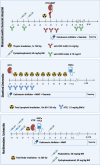Chimerism and immunological tolerance in solid organ transplantation
- PMID: 40387984
- PMCID: PMC12089243
- DOI: 10.1007/s00281-025-01052-x
Chimerism and immunological tolerance in solid organ transplantation
Abstract
In solid organ transplantation, chimerism inevitably occurs via the coexistence of donor-derived cells from the graft and host cells throughout the recipient. However, long-term immunosuppressive treatment is needed to suppress host immune responses to the foreign organ graft. The deliberate induction of stable mixed bone marrow chimerism to achieve donor-specific immunological tolerance in solid organ graft recipients is an ambitious goal that may significantly contribute to the long-term survival of solid organ grafts and their recipients. While this strategy has been effectively established in laboratory animals and some promising clinical case series have been reported, widespread clinical application is still limited by the toxicity of the necessary conditioning regimens. On the other hand, the naturally occurring chimeric state resulting from the bidirectional transplacental cell trafficking during pregnancy, the so-called feto-maternal microchimerism, can also induce immune tolerance and thus influence the outcome of mother-to-child or child-to-mother organ transplantation. This review provides an overview of the field's historical development, clinical results, and underlying principles of (micro) chimerism-based tolerance.
Keywords: Chimerism; Donor; Feto-maternal microchimerism; Organ transplantation; Recipient; Tolerance.
© 2025. The Author(s).
Conflict of interest statement
Declarations. Competing interests: All authors certify that they have no affiliation with or involvement in any organisation or entity with a financial or non-financial interest in the subject matter or materials discussed in this manuscript.
Figures




Similar articles
-
Hematopoietic cell-based and non-hematopoietic cell-based strategies for immune tolerance induction in living-donor renal transplantation: A systematic review.Transplant Rev (Orlando). 2023 Dec;37(4):100792. doi: 10.1016/j.trre.2023.100792. Epub 2023 Aug 19. Transplant Rev (Orlando). 2023. PMID: 37709652
-
Clinical relevance of feto-maternal microchimerism in (hematopoietic stem cell) transplantation.Semin Immunopathol. 2024 Dec 7;47(1):4. doi: 10.1007/s00281-024-01028-3. Semin Immunopathol. 2024. PMID: 39644358 Free PMC article. Review.
-
A systematic overview of chemotherapy effects in acute myeloid leukaemia.Acta Oncol. 2001;40(2-3):231-52. doi: 10.1080/02841860151116321. Acta Oncol. 2001. PMID: 11441935
-
Genomic identification of recipient-derived hepatocytes in liver transplantation: a hypothesis linking graft repopulation to immune tolerance.Front Immunol. 2025 Jul 31;16:1642451. doi: 10.3389/fimmu.2025.1642451. eCollection 2025. Front Immunol. 2025. PMID: 40821774 Free PMC article. Review.
-
Chimerism-Mediated Tolerance in Intestinal Transplantation.Gastroenterol Clin North Am. 2024 Sep;53(3):413-430. doi: 10.1016/j.gtc.2023.12.009. Epub 2024 Jan 16. Gastroenterol Clin North Am. 2024. PMID: 39068003 Free PMC article. Review.
Cited by
-
Micro-chimerism: from evolution to revolution.Semin Immunopathol. 2025 Aug 6;47(1):33. doi: 10.1007/s00281-025-01060-x. Semin Immunopathol. 2025. PMID: 40770572 Free PMC article. No abstract available.
References
-
- Owen RD (1945) Immunogenetic consequences of vascular anastomoses between bovine twins. Science 102:400–401. 10.1126/science.102.2651.400 - PubMed
-
- Billingham RE, Brent L, Medawar PB (1953) Actively acquired tolerance of foreign cells. Nature 172:603–606. 10.1038/172603a0 - PubMed
-
- Billingham RE, Brent L, Medawar PB (1956) Quantitative studies on tissue transplantation immunity. III. Actively acquired tolerance. Philos Trans R Soc Lond B Biol Sci 239:357–414
-
- Main JM, Prehn RT (1955) Successful skin homografts after the administration of high dosage X radiation and homologous bone marrow. JNCI: J Natl Cancer Inst 15:1023–1029. 10.1093/jnci/15.4.1023 - PubMed
-
- Dey B, Sykes M, Spitzer TR (1998) Outcomes of recipients of both bone marrow and solid organ transplants. A review. Medicine (Baltimore) 77:355–369. 10.1097/00005792-199809000-00005 - PubMed
Publication types
MeSH terms
LinkOut - more resources
Full Text Sources
Medical

